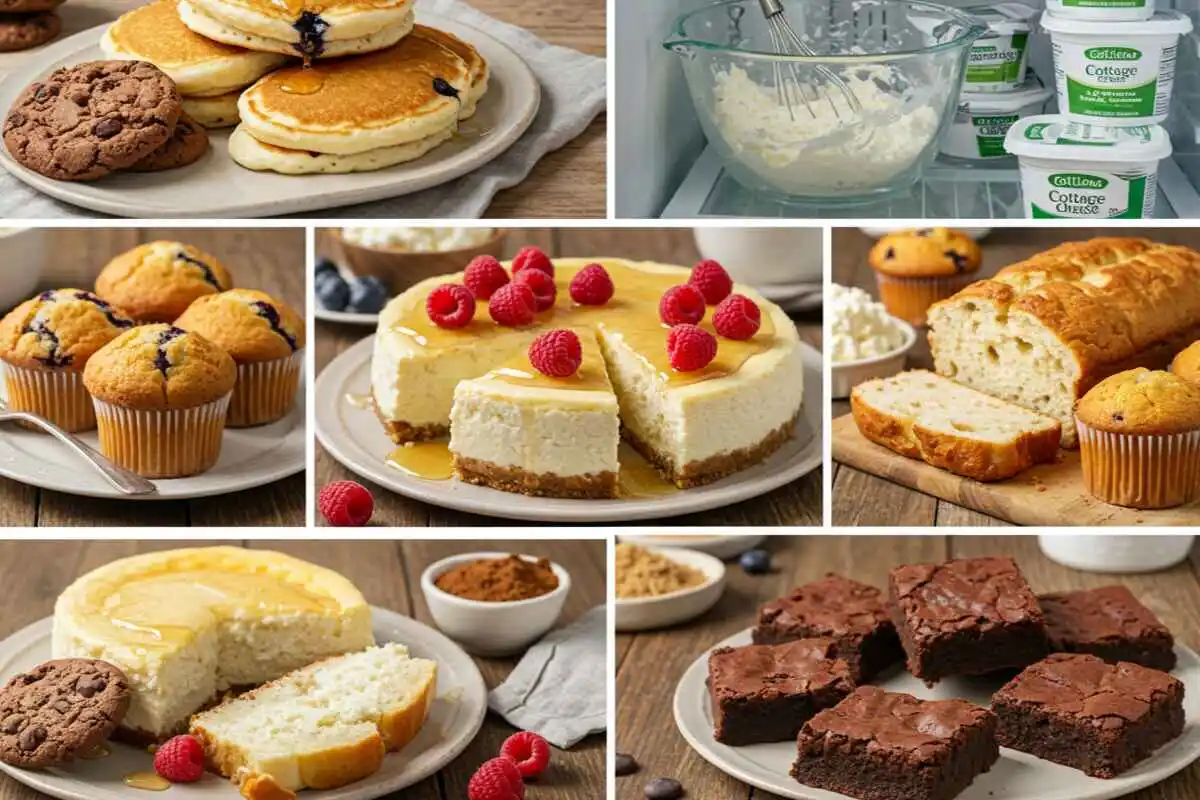Introduction
Baking is both an art and a science, requiring the right ingredients to create the perfect texture, flavor, and consistency. One lesser-known yet incredibly versatile ingredient in baking is cottage cheese. While most people associate it with a healthy snack or a protein-packed addition to meals, cottage cheese can also play a vital role in baking.
But why do bakers use cottage cheese in recipes? What benefits does it bring to baked goods? This article explores the many reasons why cottage cheese is an excellent choice for baking, including its nutritional advantages, ability to enhance texture, and role as a substitute for other dairy ingredients.
In this detailed guide, we’ll cover:
- The nutritional benefits of cottage cheese
- How it affects texture in baked goods
- The types of baked products that use cottage cheese
- Substitutes and alternatives for cottage cheese in recipes
- Common questions and answers about using cottage cheese in baking
Whether you’re looking for a healthier baking option or a way to add a unique touch to your recipes, cottage cheese might be the ingredient you’ve been missing. Let’s dive in!
Nutritional Profile of Cottage Cheese
Before understanding why cottage cheese is used in baking, it’s essential to explore its nutritional profile. This dairy product is packed with protein, low in fat, and rich in essential vitamins and minerals, making it a fantastic ingredient for both health-conscious bakers and those looking to enhance the nutritional value of their baked goods.
Macronutrient Composition
Cottage cheese is primarily made from curdled milk and contains a balanced mix of macronutrients:
| Nutrient | Amount per 100g |
|---|---|
| Calories | 98 kcal |
| Protein | 11g |
| Carbohydrates | 3.4g |
| Fats | 4.3g |
- High in Protein – Helps build and repair muscles, making baked goods more satisfying.
- Low in Carbs – Ideal for low-carb and keto-friendly recipes.
- Moderate Fat Content – Provides moisture and richness in baking.
Vitamins and Minerals in Cottage Cheese
In addition to macronutrients, cottage cheese is loaded with essential micronutrients that support overall health:
| Vitamin/Mineral | Benefit |
|---|---|
| Calcium | Strengthens bones and teeth |
| Phosphorus | Supports energy production |
| Vitamin B12 | Improves red blood cell formation |
| Riboflavin (B2) | Aids in metabolism and energy conversion |
| Selenium | Supports immune function |
These nutrients contribute to the nutritional value of baked goods, making them a better option compared to recipes that rely on high-fat or processed dairy ingredients.
Comparison with Other Dairy Products in Baking
How does cottage cheese compare to other common dairy products used in baking?
| Dairy Product | Protein | Fat | Best Used For |
|---|---|---|---|
| Cottage Cheese | High | Low to Medium | Moist cakes, muffins, protein-rich breads |
| Ricotta Cheese | Medium | High | Creamy desserts, Italian pastries |
| Cream Cheese | Low | High | Frostings, cheesecakes |
| Greek Yogurt | High | Low | Moist cakes, muffins, healthier alternatives |
From this comparison, we can see that cottage cheese provides a high-protein, lower-fat alternative to other dairy products, making it a great choice for healthier baking.
The Role of Cottage Cheese in Baking
Cottage cheese might not be the first ingredient that comes to mind when you think of baking, but it plays several key roles in creating delicious, moist, and flavorful baked goods. From improving texture to balancing moisture, cottage cheese can elevate your baking in surprising ways. Let’s explore how this humble dairy product works its magic.
Moisture Content and Its Effects on Baked Goods
One of the standout features of cottage cheese is its high moisture content. This makes it an excellent addition to recipes that need extra hydration. Moisture in cottage cheese helps:
- Keep cakes and muffins soft and tender
- Prevent dryness, especially in baked goods made with whole wheat flour
- Improve shelf life by reducing the risk of the product drying out too quickly
For example, adding cottage cheese to a banana bread recipe can make the loaf moist without relying on excessive oil or butter.
Protein Structure and Baking Properties
Cottage cheese is packed with casein, a slow-digesting protein found in dairy. This protein contributes to the structure and stability of baked goods. Here’s how it works:
- Protein helps trap air during the mixing process, leading to fluffier cakes and muffins.
- It improves the strength and elasticity of dough, making it easier to handle in recipes like bread or pastries.
- Cottage cheese adds a subtle creaminess that enhances the mouthfeel of baked goods.
Flavor Contribution
In addition to texture and structure, cottage cheese brings a distinct flavor profile to baked goods:
- It has a mild, tangy flavor that can balance sweetness in desserts.
- When used in savory recipes, cottage cheese enhances the depth of flavor by adding a hint of umami.
- Blended cottage cheese can replace ingredients like heavy cream, providing richness without overpowering the dish.
Cottage Cheese in Healthy Baking
Because of its low-fat, high-protein content, cottage cheese is a favorite in health-conscious recipes. Bakers use it to create lower-calorie versions of classic baked goods, including:
- Protein-packed muffins
- Low-carb pancakes
- Cheesecakes with reduced fat and sugar
By swapping out higher-fat dairy products for cottage cheese, you can enjoy healthier versions of your favorite treats without sacrificing taste or texture.
Health Benefits of Using Cottage Cheese in Baking
Cottage cheese is more than just a flavorful addition to baked goods—it also offers several health benefits that make it a great alternative to other dairy ingredients. Whether you’re looking to cut calories, increase protein intake, or boost the nutritional value of your treats, cottage cheese is a fantastic option.
Lower Fat Content Compared to Alternatives
One of the primary reasons people choose cottage cheese over traditional dairy products like cream cheese or butter is its lower fat content.
| Ingredient | Fat per 100g | Calories per 100g |
|---|---|---|
| Cottage Cheese (Low-Fat) | 1-2g | 80-100 kcal |
| Ricotta Cheese | 10g | 174 kcal |
| Cream Cheese | 34g | 342 kcal |
| Butter | 81g | 717 kcal |
By substituting cottage cheese in recipes, you can reduce the fat content while maintaining a creamy and rich texture. This makes it perfect for those on low-fat diets or looking to cut back on unnecessary calories.
High Protein Benefits
Cottage cheese is protein-rich, making it an excellent choice for individuals looking to increase their protein intake. This is particularly beneficial for:
- Athletes and fitness enthusiasts needing protein for muscle repair
- People following high-protein or low-carb diets like keto
- Anyone looking for a filling, nutrient-dense ingredient in baked goods
A single cup of cottage cheese contains around 25 grams of protein, significantly more than cream cheese or butter. This helps keep you full for longer while improving the texture and structure of baked goods.
Probiotic and Gut Health Advantages
Some varieties of cottage cheese contain probiotics, which are beneficial bacteria that support gut health. Probiotics can:
- Improve digestion
- Enhance nutrient absorption
- Strengthen the immune system
While not all cottage cheese brands contain live cultures, choosing a probiotic-rich version can add extra health benefits to your baked goods.
Rich in Essential Nutrients
Cottage cheese is loaded with calcium, phosphorus, and B vitamins, which support bone health, energy production, and metabolism. This makes it an ideal ingredient for those looking to boost their nutrient intake through everyday baking.
A Great Option for Weight Management
Because cottage cheese is low in calories, high in protein, and filling, it can be beneficial for weight loss and appetite control. Adding it to baked goods can:
- Reduce overall calorie intake
- Make treats more satisfying
- Help prevent overeating
Whether you’re baking protein-rich pancakes or low-fat cheesecakes, cottage cheese can be an essential ingredient for healthier baking.
Common Baked Goods Incorporating Cottage Cheese
Cottage cheese is a versatile ingredient that can be used in a wide variety of baked goods, from sweet desserts to savory bread. Whether blended smooth or left slightly chunky for texture, it enhances recipes by adding moisture, richness, and protein. Let’s explore some popular baked goods that use cottage cheese.
Breads and Rolls
Adding cottage cheese to bread dough creates a soft, moist texture while boosting protein content. Some common breads that incorporate cottage cheese include:
- Cottage Cheese Bread – A soft, protein-rich bread with a slight tangy flavor.
- Savory Herb Rolls – Cottage cheese keeps these rolls tender while adding depth of flavor.
- Cheese and Garlic Naan – A delicious twist on traditional naan with extra cheesiness.
Best Tip: Blend the cottage cheese before adding it to the dough for an even texture.
Muffins and Cupcakes
Muffins and cupcakes benefit from cottage cheese’s ability to retain moisture without excessive butter or oil. Some great options include:
- Protein-Packed Blueberry Muffins – A healthy alternative to traditional muffins.
- Chocolate Cottage Cheese Cupcakes – Rich and moist, with added protein.
- Pumpkin Spice Muffins – Cottage cheese adds creaminess to these fall favorites.
Best Tip: Use full-fat cottage cheese for extra richness in muffins.
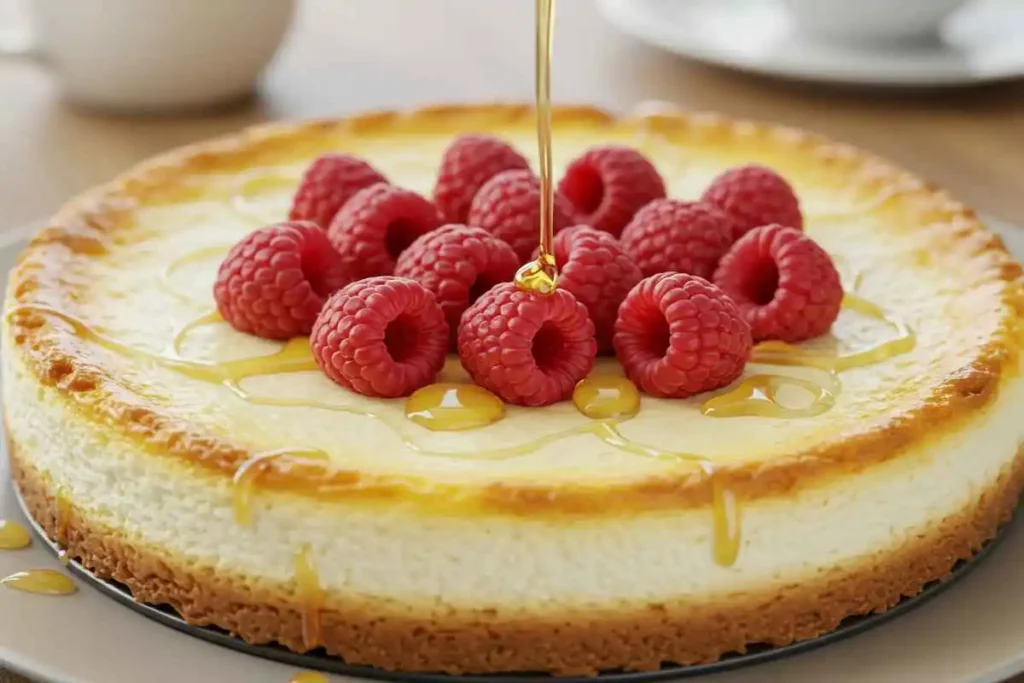
Cheesecakes and Tarts
Cottage cheese is commonly used as a lower-fat substitute for cream cheese or ricotta in cheesecakes. Popular recipes include:
- Classic Cottage Cheese Cheesecake – Lighter than traditional cheesecakes but just as creamy.
- Mini Cheesecake Bites – Perfect for portion control with a protein boost.
- Berry Cottage Cheese Tart – A healthier dessert with a tangy flavor.
Best Tip: Blend the cottage cheese to remove lumps and achieve a smooth, creamy texture.
Pancakes and Waffles
Cottage cheese makes pancakes and waffles fluffier, protein-packed, and nutritious. Some delicious recipes include:
- Cottage Cheese Protein Pancakes – A favorite among fitness enthusiasts.
- Banana Cottage Cheese Waffles – Moist and naturally sweet.
- Savory Cottage Cheese Pancakes – Great for breakfast or brunch.
Best Tip: Combine cottage cheese with eggs and oat flour for a gluten-free option.
Pastries and Dough-Based Treats
Certain pastries and dough-based treats also incorporate cottage cheese for extra richness and softness:
- Eastern European Cheese Pastries – Such as piroshki and bourekas, which use cottage cheese for a creamy filling.
- Cottage Cheese Danish – A lighter take on the classic Danish pastry.
- Savory Cottage Cheese Scones – Ideal for pairing with soups or salads.
Best Tip: For fillings, mix cottage cheese with herbs or fruit for extra flavor complexity.
Substituting Cottage Cheese for Other Ingredients
Cottage cheese is a versatile ingredient that can replace several dairy products in baking. Whether you’re looking for a lower-fat alternative, a higher-protein option, or simply a different texture, cottage cheese can be an excellent substitute. Let’s explore how to swap it for cream cheese, ricotta, butter, and other ingredients in various recipes.
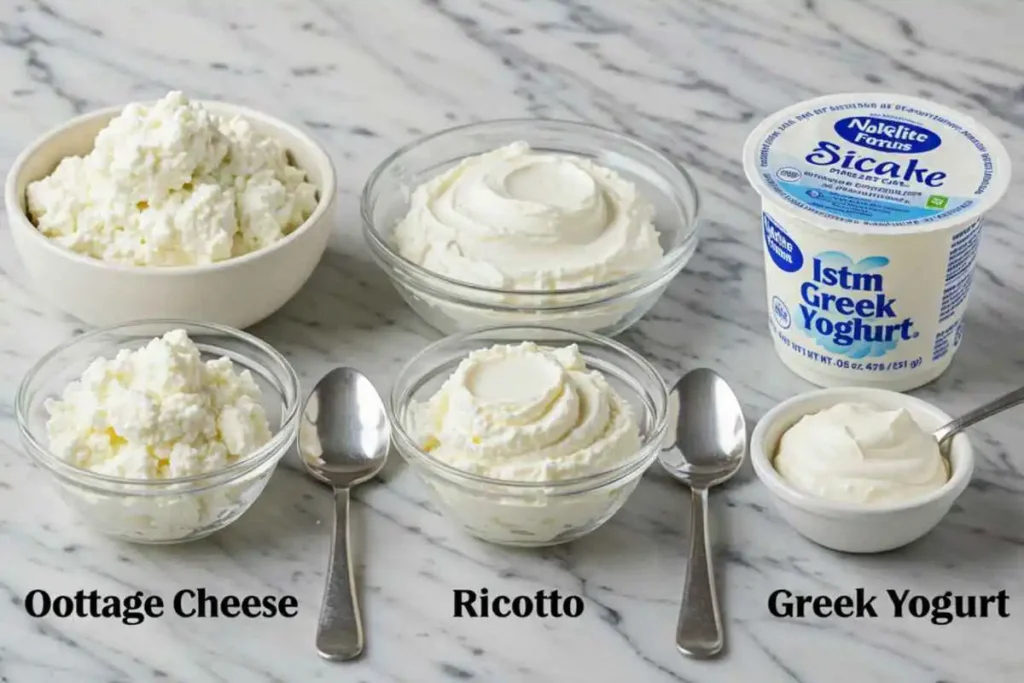 Replacing Cream Cheese with Cottage Cheese
Replacing Cream Cheese with Cottage Cheese
Cream cheese is often used in cheesecakes, frostings, and creamy desserts. However, cottage cheese can be used as a lower-fat alternative.
✔️ How to Substitute:
- Blend cottage cheese until smooth to mimic the creamy texture of cream cheese.
- Add a touch of yogurt or sour cream to balance the consistency and tanginess.
✔️ Best Recipes for This Swap:
- Cheesecakes
- Frostings and spreads
- Creamy fillings for pastries
Tip: If the recipe requires a firm texture, drain the excess liquid from the cottage cheese before blending.
Replacing Ricotta Cheese with Cottage Cheese 🥛
Cottage cheese is often used as a substitute for ricotta in both sweet and savory dishes. Since both cheeses have a slightly grainy texture, they work well in similar recipes.
✔️ How to Substitute:
- Use equal amounts of blended cottage cheese in place of ricotta.
- If a recipe calls for sweet ricotta, add a bit of honey or vanilla extract.
- If a thicker consistency is needed, strain the cottage cheese using a cheesecloth.
✔️ Best Recipes for This Swap:
- Lasagna
- Cannoli filling
- Ricotta pancakes
Tip: Ricotta is slightly sweeter than cottage cheese, so adjust seasonings accordingly when swapping.
Using Cottage Cheese Instead of Butter or Oil
For low-fat baking, cottage cheese can replace butter or oil in certain recipes. It keeps baked goods moist while reducing calories and fat.
✔️ How to Substitute:
- Replace 50% of the butter or oil with blended cottage cheese for moisture.
- For fat-free baking, replace all the butter but expect a slightly different texture.
✔️ Best Recipes for This Swap:
- Muffins and quick breads
- Cakes and brownies
- Pancakes and waffles
Tip: Since cottage cheese has a high water content, slightly reduce other liquids in the recipe to maintain consistency.
Substituting Cottage Cheese for Milk or Yogurt
If a recipe calls for milk or yogurt, cottage cheese can be a great replacement, especially for those wanting extra protein.
✔️ How to Substitute:
- Blend cottage cheese with a little water or milk to achieve a pourable consistency.
- Use a 1:1 ratio when replacing yogurt in recipes.
✔️ Best Recipes for This Swap:
- Smoothies and protein shakes
- Pancakes and waffles
- Breads and scones
Tip: Use full-fat cottage cheese for a creamier texture in recipes.
When Not to Use Cottage Cheese as a Substitute
Although cottage cheese is an excellent swap in many recipes, there are cases where it doesn’t work well:
- In recipes that require melting – Cottage cheese doesn’t melt like butter or cheese.
- In dry doughs – High moisture content can make certain doughs too wet.
- In delicate frostings – Unless blended, cottage cheese may create a grainy texture.
By understanding these substitutions, you can make healthier, high-protein, and lower-fat versions of your favorite baked goods while still maintaining delicious flavor and texture.
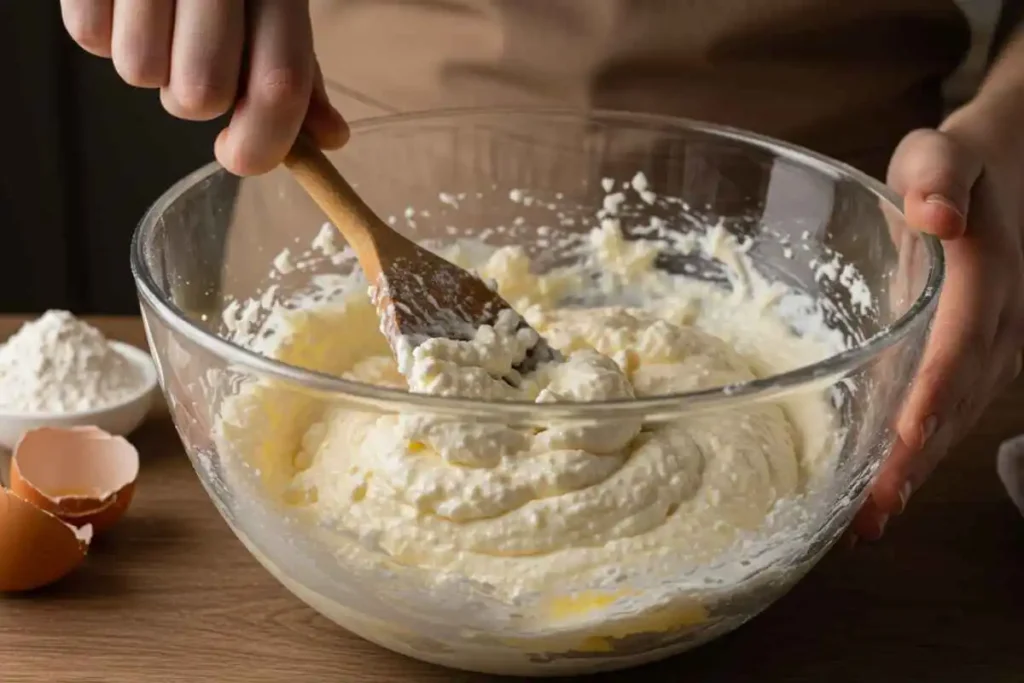
Techniques for Incorporating Cottage Cheese into Batter and Dough
Cottage cheese is a fantastic ingredient for baking, but using it correctly is key to achieving the best texture and flavor in your baked goods. Whether you’re making muffins, cakes, or bread, knowing how to blend, fold, and balance moisture levels can make a big difference.
Blending for Smoothness
One common challenge with cottage cheese in baking is its grainy texture. In some recipes, this works well, but in others, a smooth consistency is needed.
✔️ How to Achieve a Smooth Texture:
- Use a blender or food processor – Blend the cottage cheese until it becomes creamy and lump-free.
- Strain excess liquid – If the cheese is too wet, use a fine mesh strainer or cheesecloth to remove moisture.
- Mix with yogurt or milk – Adding a small amount of liquid makes blending easier and helps achieve a smoother texture.
✔️ Best Recipes for This Method:
- Cheesecakes
- Smooth cake batters
- Pancakes and waffles
Tip: If you prefer some texture in your baked goods, blend half of the cottage cheese and leave the rest as is.
Folding into Mixtures for Texture
For certain baked goods, keeping the curds intact adds a unique texture. This works well for rustic-style baked goods and dishes where slight cheesiness enhances the flavor.
✔️ How to Fold Cottage Cheese into Batter:
- Gently stir it in at the end of mixing to avoid breaking the curds too much.
- Combine with dry ingredients first, then add wet ingredients to distribute the curds evenly.
- Use larger curd cottage cheese for a more noticeable texture.
✔️ Best Recipes for This Method:
- Muffins and scones
- Biscuits and cornbread
- Savory bread rolls
Tip: Avoid over-mixing, as it can break the curds completely and impact the final texture.
Balancing Moisture Levels in Dough
Cottage cheese contains a high amount of water, which can affect the consistency of your dough or batter. Adjusting other ingredients can help maintain the right balance.
✔️ How to Adjust for Moisture:
- Reduce other liquid ingredients (milk, water) if using a lot of cottage cheese.
- If a dough becomes too wet, add extra flour a little at a time until the right consistency is achieved.
- Drain excess moisture from cottage cheese before using it in drier doughs like cookies or pastries.
✔️ Best Recipes for This Method:
- Cookie dough
- Bread dough
- Pie crusts
Tip: Use low-fat or dry-curd cottage cheese for recipes requiring less moisture.
Enhancing the Rise of Baked Goods
Cottage cheese can improve the rise and structure of baked goods when combined with leavening agents.
✔️ How to Use Cottage Cheese for Better Rise:
- Pair it with baking powder or baking soda – The acidity in cottage cheese helps activate these leavening agents.
- Combine with eggs – The protein in eggs and cottage cheese strengthens the structure of baked goods.
- Let the batter rest for a few minutes before baking to allow air bubbles to form.
✔️ Best Recipes for This Method:
- Fluffy pancakes
- Light and airy muffins
- Soft dinner rolls
Tip: If using low-fat cottage cheese, add a bit of oil or butter to maintain richness and structure.
By mastering these techniques, you can make the most out of cottage cheese in your baking, enhancing texture, moisture, and rise while keeping recipes healthier and protein-rich.
Flavor Pairings with Cottage Cheese in Baking
Cottage cheese has a mild, slightly tangy flavor, making it an incredibly versatile ingredient in baking. It pairs well with both sweet and savory flavors, allowing for endless creative combinations. Whether you’re making a dessert or a savory dish, knowing the right pairings can enhance the taste of your baked goods.
Sweet Pairings for Cottage Cheese
When used in sweet recipes, cottage cheese complements fruity, nutty, and spiced flavors beautifully. Here are some of the best sweet pairings:
| Flavor | Best Ways to Use with Cottage Cheese |
|---|---|
| Honey | Drizzle over cheesecakes or blend into batters |
| Cinnamon | Adds warmth to muffins, pancakes, and pastries |
| Vanilla | Enhances sweetness in cakes and cookies |
| Berries (Blueberries, Raspberries, Strawberries) | Perfect for cheesecakes, muffins, and tarts |
| Lemon or Orange Zest | Brightens flavors in breads and scones |
| Dark Chocolate | Creates a rich contrast in brownies and cupcakes |
| Almonds & Walnuts | Adds crunch and depth to cottage cheese pastries |
✔️ Best Sweet Recipes for Cottage Cheese:
- Cottage Cheese Cheesecake
- Berry Muffins with Cottage Cheese
- Honey-Cinnamon Cottage Cheese Pancakes
Tip: If using cottage cheese in a sweet dish, blend it smoothly and mix with a natural sweetener like honey or maple syrup to enhance its flavor.
Savory Pairings for Cottage Cheese
Cottage cheese’s creamy texture and mild tang make it perfect for savory baked goods. It works well with:
| Flavor | Best Ways to Use with Cottage Cheese |
|---|---|
| Garlic & Onion | Adds a depth of flavor in biscuits and bread |
| Black Pepper & Paprika | Enhances the richness of baked casseroles |
| Cheddar & Parmesan | Combines well in cheesy bread and scones |
| Spinach & Kale | Great for savory muffins and quiches |
| Sun-Dried Tomatoes | Adds a tangy, umami punch to pastries |
| Dill & Chives | Works well in savory scones and rolls |
✔️ Best Savory Recipes for Cottage Cheese:
- Cottage Cheese & Herb Biscuits
- Cheese & Spinach Scones
- Savory Cottage Cheese Muffins
Tip: When using cottage cheese in savory baking, choose full-fat varieties for extra creaminess and blend it to make it smoother for even distribution.
Balancing Flavors in Baked Goods
When baking with cottage cheese, achieving the right balance of flavors is key. Here’s how:
- For sweet recipes: Add a touch of honey or vanilla to counter the slight tanginess of cottage cheese.
- For savory recipes: Use herbs, spices, or salt to enhance the umami taste of cottage cheese.
- For bold flavors: Cottage cheese is mild, so pair it with stronger ingredients like dark chocolate, citrus zest, or sharp cheese.
By pairing cottage cheese with the right flavors, you can create delicious, well-balanced baked goods that taste as amazing as they look.
Cultural and Regional Baked Goods Featuring Cottage Cheese
Cottage cheese has been used in baking across various cultures and cuisines for centuries. From Eastern European pastries to American classics, this versatile ingredient appears in many traditional recipes. Let’s explore some of the most famous baked goods featuring cottage cheese from around the world.
Eastern European Pastries and Baked Goods 🇷🇺🇵🇱🇭🇺
Cottage cheese plays a central role in many Eastern European baked treats, especially in sweet and savory pastries.
✔️ Popular Eastern European Baked Goods with Cottage Cheese:
| Baked Good | Country of Origin | Description |
|---|---|---|
| Syrniki | Russia, Ukraine | Small, pan-fried cottage cheese pancakes, often served with honey or jam. |
| Kolaches | Czech Republic, Slovakia | Sweet yeast pastries filled with cottage cheese, fruit, or poppy seeds. |
| Babka with Cottage Cheese | Poland | A rich, twisted bread filled with sweetened cottage cheese. |
| Turos Csusza | Hungary | Baked pasta with cottage cheese, often served with crispy bacon. |
| Börek | Turkey, Balkans | Savory phyllo pastry filled with cottage cheese and spinach. |
Tip: These recipes often use farmer’s cheese, which is similar to dry-curd cottage cheese. If using regular cottage cheese, strain excess liquid for a firmer texture.
American and Western Baked Goods 🇺🇸🇬🇧
In the United States and Western Europe, cottage cheese is commonly used in cheesecakes, quick breads, and pancakes.
✔️ Popular Western Baked Goods Featuring Cottage Cheese:
- Cottage Cheese Cheesecake – A lighter alternative to classic New York cheesecake.
- Protein Muffins & Pancakes – High-protein breakfast options with a creamy texture.
- Cottage Cheese Banana Bread – A healthier take on traditional banana bread.
- Savory Cottage Cheese Scones – A great pairing for soups and stews.
Tip: Western recipes often blend cottage cheese for a smoother texture in cheesecakes and muffins.
Indian and Middle Eastern Uses of Cottage Cheese in Baking 🇮🇳🇮🇷
While cottage cheese isn’t a traditional ingredient in Indian or Middle Eastern baking, it can often be used as a substitute for paneer in some dishes.
✔️ Baked Goods Where Cottage Cheese Can Be Used as a Substitute:
- Rasmalai Cheesecake – A fusion dessert using blended cottage cheese instead of paneer.
- Baked Samosas – A healthier take on samosas, with a cottage cheese filling.
- Naan Bread with Cottage Cheese – Soft, fluffy naan with cottage cheese mixed into the dough.
Tip: If substituting cottage cheese for paneer, make sure to drain and press out excess liquid for a firmer consistency.
Asian Adaptations of Cottage Cheese in Baking 🇯🇵🇨🇳
Asian cuisines don’t traditionally use cottage cheese in baking, but modern adaptations incorporate it into Japanese cheesecakes and fusion pastries.
✔️ Asian-Inspired Cottage Cheese Bakes:
- Japanese Cotton Cheesecake – Light and fluffy, often made with blended cottage cheese instead of cream cheese.
- Matcha Muffins with Cottage Cheese – A protein-rich muffin infused with green tea.
- Cottage Cheese Custard Buns – A twist on classic Chinese custard buns, using sweetened cottage cheese.
Tip: For Japanese and Chinese baked goods, blend cottage cheese thoroughly to achieve a smooth, silky texture.
Latin American Baked Goods with Cottage Cheese 🇲🇽🇦🇷
Latin American cuisines use a variety of cheeses in baking, and cottage cheese can be a substitute in savory and sweet pastries.
✔️ Popular Latin American Bakes Featuring Cottage Cheese:
- Empanadas with Cottage Cheese & Spinach – A lighter, protein-rich filling.
- Quesadillas de Requesón – A Mexican pastry filled with cottage cheese (called “requesón” in Spanish).
- Cottage Cheese Tres Leches Cake – A twist on the traditional Latin American cake.
Tip: Cottage cheese works well as a low-fat alternative in Latin desserts and pastries.
Final Thoughts on Cultural Uses of Cottage Cheese in Baking
Cottage cheese has a global presence in baking, appearing in both traditional and modern recipes. Whether used in Russian syrniki, American cheesecakes, or Turkish börek, this ingredient brings creaminess, moisture, and nutrition to countless baked goods.
Innovative Recipes Using Cottage Cheese
Cottage cheese is not just for traditional baked goods—it’s also perfect for modern, creative recipes that are both delicious and nutritious. Whether you’re looking for high-protein snacks, gluten-free options, or indulgent desserts, these innovative recipes will show you how versatile cottage cheese can be in baking.
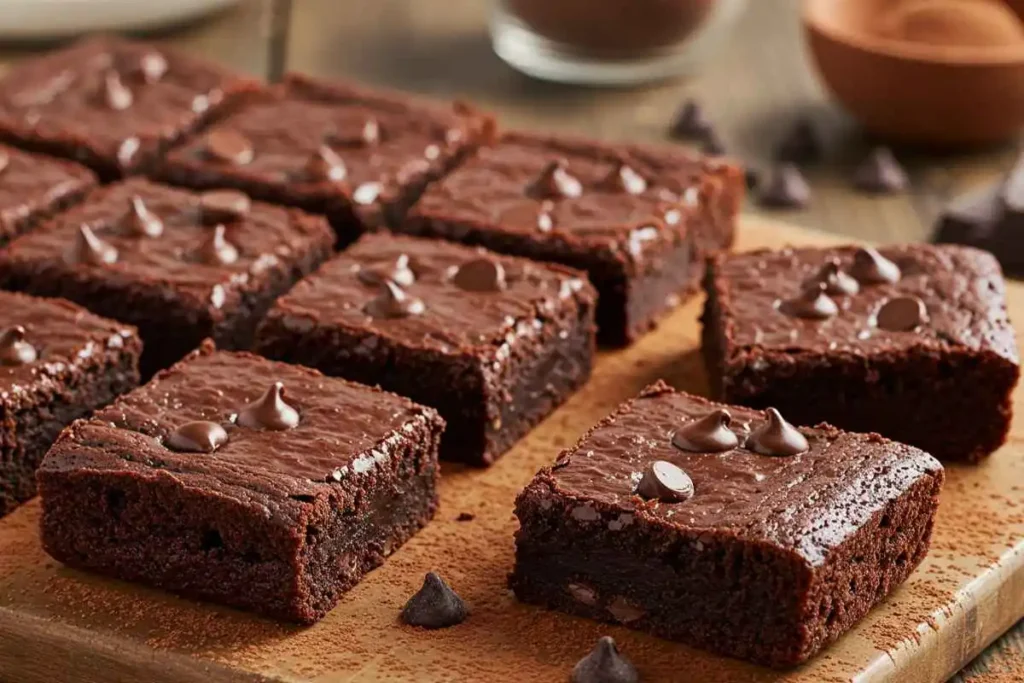
Cottage Cheese Brownies (High-Protein & Guilt-Free)
Why It Works:
- Cottage cheese adds moisture and protein while reducing the need for butter.
- It gives brownies a rich, fudgy texture without excess fat.
✔️ Ingredients:
- 1 cup blended cottage cheese
- 1/2 cup cocoa powder
- 1/3 cup honey or maple syrup
- 1/2 cup oat flour (or almond flour for gluten-free)
- 1 tsp vanilla extract
- 1/2 tsp baking powder
- 1/4 cup dark chocolate chips
✔️ Instructions:
- Blend cottage cheese until smooth.
- Mix all ingredients together until a thick batter forms.
- Pour into a greased baking dish and bake at 350°F (175°C) for 20-25 minutes.
- Let cool before slicing.
Tip: For extra fudginess, slightly underbake and let brownies set in the fridge overnight.
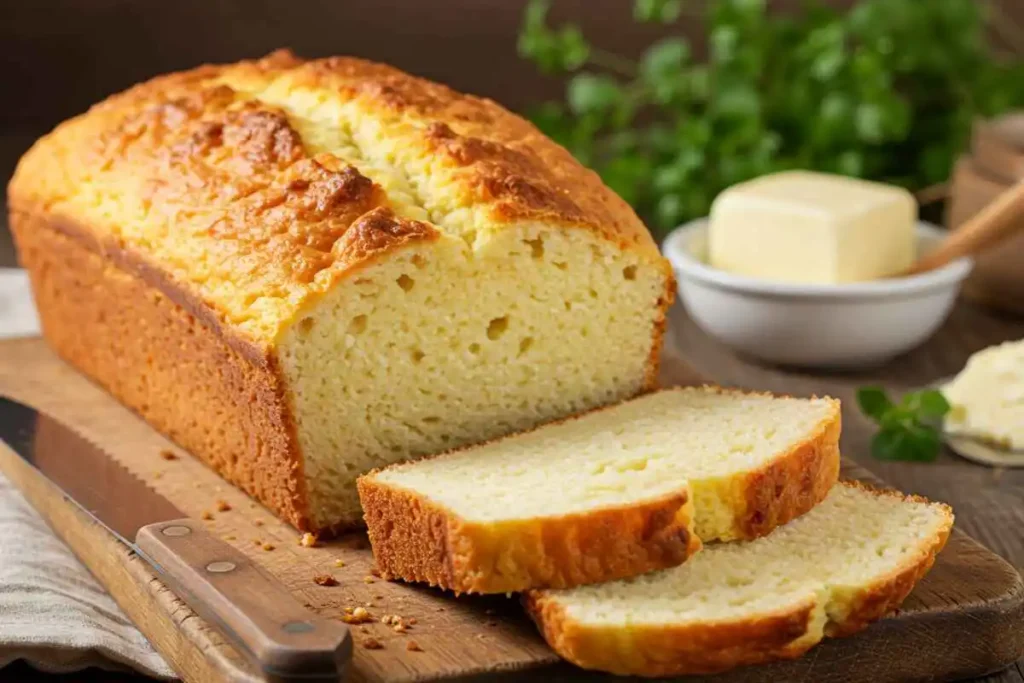 Protein-Rich Cottage Cheese Bread
Protein-Rich Cottage Cheese Bread
Why It Works:
- Cottage cheese makes the bread soft and moist while boosting protein content.
- Great for sandwiches or as a side for soups.
✔️ Ingredients:
- 1 ½ cups cottage cheese
- 2 cups whole wheat flour
- 1 ½ tsp baking soda
- 1 tsp salt
- 1 tbsp honey
- 2 eggs
✔️ Instructions:
- Blend cottage cheese until smooth.
- Combine with flour, baking soda, and salt.
- Add eggs and honey, mixing until a dough forms.
- Transfer to a greased loaf pan and bake at 350°F (175°C) for 40-45 minutes.
Tip: Add herbs and garlic for a savory version!
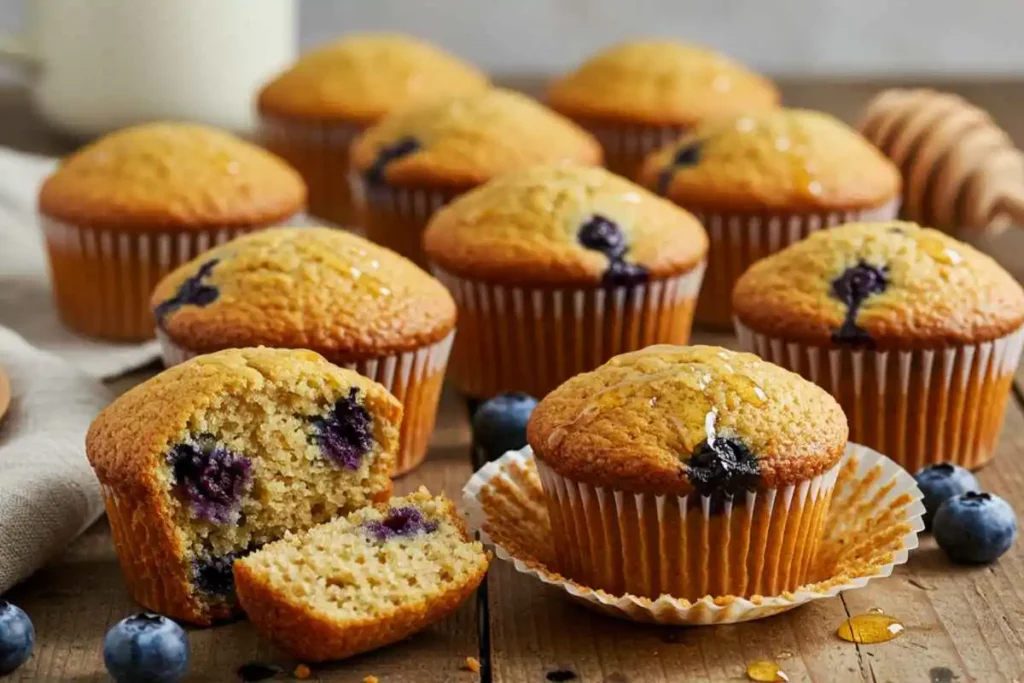 Gluten-Free Cottage Cheese Muffins
Gluten-Free Cottage Cheese Muffins
Why It Works:
- Cottage cheese adds moisture and richness to gluten-free bakes.
- Works well with oat flour or almond flour.
✔️ Ingredients:
- 1 cup cottage cheese
- 2 eggs
- 1 cup oat flour
- ½ tsp baking soda
- 2 tbsp honey
- ½ tsp cinnamon
✔️ Instructions:
- Blend cottage cheese until smooth.
- Mix all ingredients together until smooth.
- Spoon into muffin cups and bake at 350°F (175°C) for 18-20 minutes.
Tip: Mix in blueberries or chocolate chips for extra flavor.
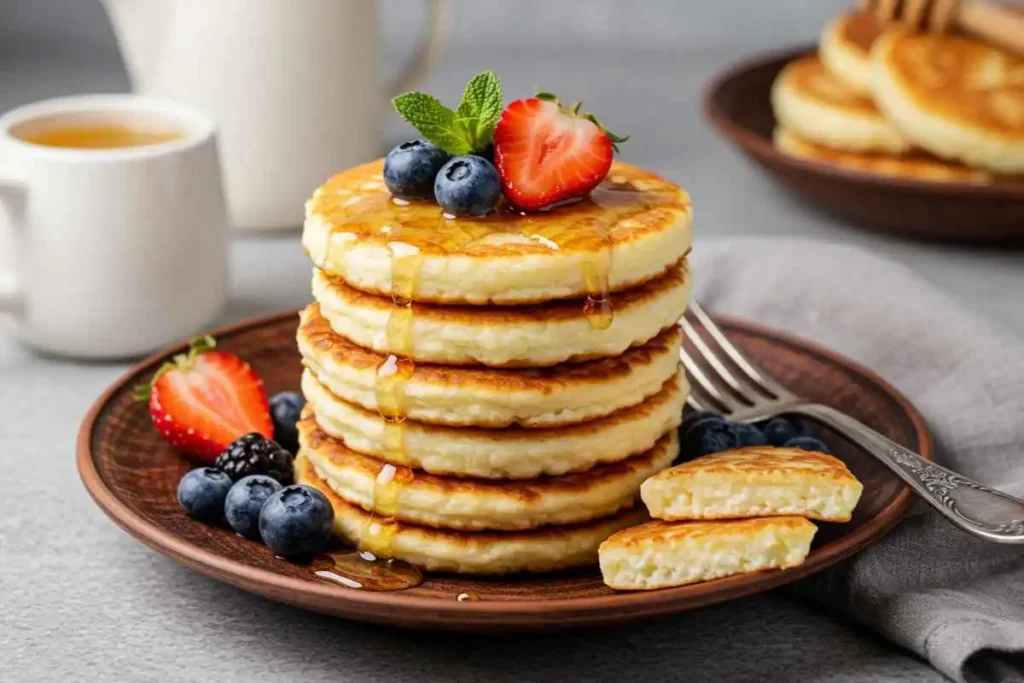
Cottage Cheese Pancakes (Low-Carb & Fluffy!)
Why It Works:
- Cottage cheese makes pancakes extra fluffy while adding protein.
- No refined flour—uses oat flour or almond flour instead.
✔️ Ingredients:
- 1 cup cottage cheese
- 2 eggs
- ½ cup oat flour
- ½ tsp baking powder
- 1 tsp vanilla
✔️ Instructions:
- Blend cottage cheese until smooth.
- Mix all ingredients until well combined.
- Cook pancakes on a greased skillet over medium heat, flipping once bubbles form.
Tip: Serve with honey, berries, or peanut butter for a protein-packed breakfast.
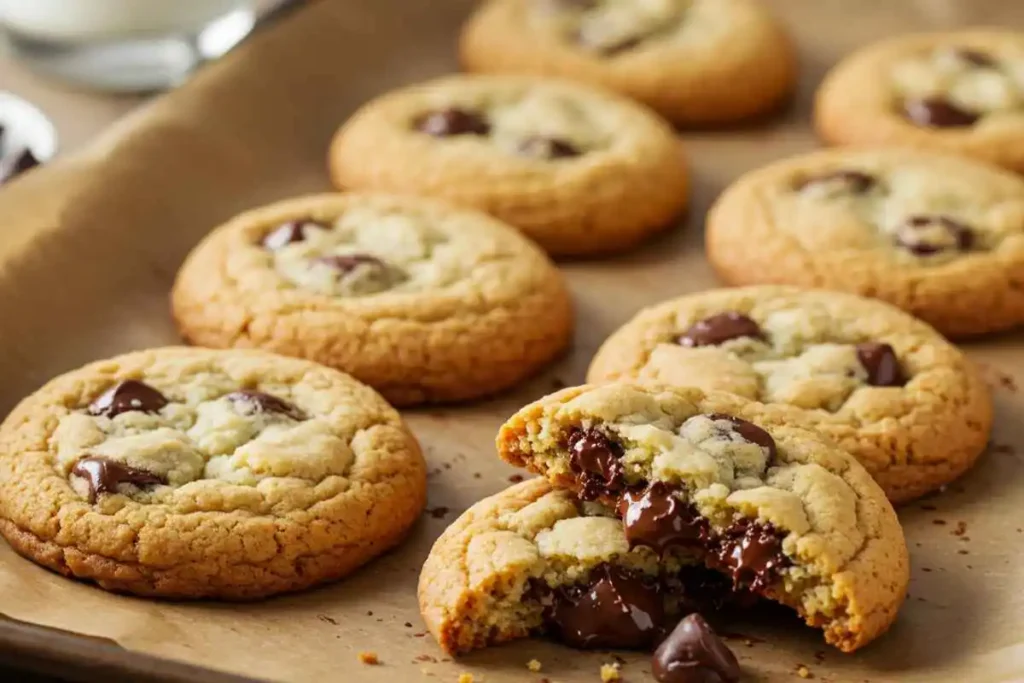
Cottage Cheese Chocolate Chip Cookies
Why It Works:
- Cottage cheese replaces some butter for a lower-fat, high-protein cookie.
- Results in chewy, soft cookies.
✔️ Ingredients:
- ½ cup cottage cheese (blended)
- 1 ½ cups all-purpose flour
- ½ tsp baking soda
- ¼ cup brown sugar
- ¼ cup honey
- 1 egg
- ½ cup chocolate chips
✔️ Instructions:
- Blend cottage cheese until smooth.
- Mix with sugar, honey, and egg.
- Stir in flour, baking soda, and chocolate chips.
- Drop spoonfuls onto a baking sheet and bake at 350°F (175°C) for 10-12 minutes.
Tip: Refrigerate dough for 30 minutes before baking for better texture.
These creative cottage cheese recipes prove that it’s an incredibly versatile ingredient in baking. Whether you’re making healthy brownies, protein-packed pancakes, or gluten-free muffins, cottage cheese enhances texture, flavor, and nutrition in every bite.
Tips for Selecting the Right Cottage Cheese for Baking
Choosing the right cottage cheese for baking can significantly impact the texture, flavor, and moisture of your final product. From fat content to curd size, here’s how to pick the best type of cottage cheese for your recipes.
Fat Content Considerations
Cottage cheese comes in various fat levels, which can affect the outcome of your baked goods.
| Type of Cottage Cheese | Fat Content | Best For |
|---|---|---|
| Full-Fat Cottage Cheese | 4% fat | Rich and moist cheesecakes, muffins |
| Low-Fat Cottage Cheese | 1-2% fat | Pancakes, protein muffins, bread |
| Fat-Free Cottage Cheese | 0% fat | Light recipes, low-calorie bakes |
✔️ When to Use Full-Fat Cottage Cheese:
- If you want extra creaminess in cheesecakes and muffins.
- For moist texture in cakes and brownies.
✔️ When to Use Low-Fat or Fat-Free Cottage Cheese:
- If you’re making healthier, low-calorie recipes.
- For high-protein pancakes, breads, and muffins.
Tip: Full-fat cottage cheese creates richer baked goods, while low-fat versions work best in lighter, drier recipes.
Choosing Between Small or Large Curd Cottage Cheese
Cottage cheese is available in small or large curd varieties. The difference lies in texture and how it interacts with other ingredients.
| Curd Size | Best Used For |
|---|---|
| Small Curd | Smooth cheesecakes, muffins, blended batters |
| Large Curd | Rustic bread, textured pastries, savory scones |
✔️ Use Small Curd Cottage Cheese When:
- You need a smooth texture (muffins, cakes, pancakes).
- You plan to blend it for creamy batters.
✔️ Use Large Curd Cottage Cheese When:
- You want visible cheese pieces in scones or biscuits.
- You prefer a chunky, textured filling in pastries.
Tip: If a recipe calls for ricotta, use small curd cottage cheese for a similar texture.
Checking for Added Ingredients and Freshness
Some cottage cheese brands contain stabilizers, gums, or extra salt, which can affect baking results.
✔️ What to Look for in Quality Cottage Cheese:
- Minimal ingredients – Choose brands with just milk, cultures, and salt.
- Low sodium – Too much salt can interfere with the balance of flavors in baked goods.
- No added stabilizers – Some brands add gums or thickeners, which can affect texture.
✔️ How to Tell If Cottage Cheese Is Fresh:
- It should have a mild, slightly tangy smell (no sour or off-putting odors).
- The texture should be creamy, not watery or overly dry.
- Check the expiration date and use it within a few days after opening.
Tip: For the freshest taste, buy organic or freshly made cottage cheese from a local dairy.
How to Store Cottage Cheese for Baking
Since cottage cheese is perishable, proper storage is essential.
✔️ Best Storage Practices:
- Keep refrigerated at all times (below 40°F / 4°C).
- Use within 5-7 days after opening.
- If it separates, stir gently before using.
- Avoid freezing, as it alters texture and makes it grainy.
Tip: If you need cottage cheese for later use in baking, blend it first, then freeze it in an airtight container.
By choosing the right type of cottage cheese, you can enhance your baking results, ensuring the best texture, flavor, and consistency in your recipes.
Potential Challenges and Solutions When Baking with Cottage Cheese
While cottage cheese is a fantastic ingredient for baking, it does come with a few challenges. Issues like curdling, excess moisture, and texture inconsistencies can affect the outcome of your baked goods. Here’s how to solve the most common problems when using cottage cheese in baking.
Preventing Cottage Cheese from Curdling
Problem: Cottage cheese can curdle or separate when exposed to high heat, leading to an unpleasant texture.
✔️ Solutions:
- Blend the cottage cheese before using it in batters. This helps create a smooth texture that integrates better with other ingredients.
- Add an acid (like lemon juice or vinegar) – A small amount helps stabilize cottage cheese and prevents separation.
- Use room-temperature cottage cheese – Cold cottage cheese straight from the fridge can cause uneven mixing and curdling.
Tip: If making cheesecakes or creamy fillings, always blend cottage cheese for a silky consistency.
Managing Excess Moisture in Dough and Batter
Problem: Cottage cheese has high water content, which can make batters too runny or dough too sticky.
✔️ Solutions:
- Drain excess liquid – Use a fine mesh strainer or cheesecloth to remove extra moisture before adding it to recipes.
- Reduce other liquid ingredients – If a recipe calls for milk or yogurt, decrease the amount slightly when using cottage cheese.
- Choose dry-curd or low-moisture cottage cheese for recipes that require a firmer texture.
Tip: If making cookies or pastries, always strain cottage cheese first to prevent excess moisture.
Achieving the Right Texture in Baked Goods
Problem: Cottage cheese can create a grainy texture if not properly blended or mixed.
✔️ Solutions:
- Blend cottage cheese until smooth before adding it to recipes like cakes, muffins, and cheesecakes.
- Combine with other creamy ingredients like Greek yogurt or sour cream for a smoother texture.
- For chunkier textures, leave some curds whole in recipes like biscuits or scones.
Tip: If blending cottage cheese, add a splash of milk to help achieve a creamier consistency.
Ensuring Even Distribution in Batter
Problem: Cottage cheese can sometimes clump together in batter, leading to uneven texture.
✔️ Solutions:
- Mix it separately first – Blend cottage cheese with eggs or wet ingredients before incorporating it into the batter.
- Use small-curd cottage cheese for smoother distribution in muffins, pancakes, and bread.
- Sift dry ingredients before mixing – This prevents uneven pockets of flour or cheese.
Tip: If a recipe calls for a whipped or smooth texture, always blend cottage cheese before mixing.
Adjusting the Flavor of Cottage Cheese in Baking
Problem: Some people find the slight tanginess of cottage cheese too noticeable in baked goods.
✔️ Solutions:
- Balance sweetness – Add a bit more honey, vanilla, or cinnamon in sweet recipes to counteract the tang.
- Pair with bold flavors like dark chocolate, berries, or citrus to mask the taste.
- Use a mild variety – Some brands have a stronger tangy taste, so experiment with different ones.
Tip: If you prefer a neutral flavor, mix cottage cheese with cream cheese or yogurt for a milder taste.
By following these troubleshooting tips, you can overcome the most common baking challenges with cottage cheese and create smooth, delicious, and perfectly textured baked goods.
Storing and Preserving Baked Goods Made with Cottage Cheese
Baked goods made with cottage cheese can stay fresh and delicious for several days if stored properly. However, because cottage cheese has a high moisture content, it’s important to use the right techniques to prevent spoilage, dryness, or texture loss.
Shelf Life of Cottage Cheese Baked Goods
The shelf life of baked goods made with cottage cheese depends on the type of recipe and storage method.
| Baked Good | Room Temperature (68-72°F) | Refrigerated (35-40°F) | Frozen (0°F or below) |
|---|---|---|---|
| Muffins & Bread | 2-3 days | 5-7 days | 2-3 months |
| Cheesecake & Custard-Based Desserts | Not recommended | 4-5 days | 2 months |
| Cookies & Brownies | 3-4 days | 7-10 days | 3 months |
| Savory Scones & Biscuits | 1-2 days | 4-6 days | 2 months |
Tip: Always store moist baked goods (like cheesecakes or muffins) in the fridge, while low-moisture ones (like cookies or scones) can stay at room temperature for a short period.
Best Storage Practices for Freshness
For Room-Temperature Storage:
- Store in an airtight container to prevent drying out.
- Keep in a cool, dry place away from direct sunlight.
- If the baked good is very moist, consider refrigeration instead.
✔️ For Refrigeration:
- Wrap tightly with plastic wrap or place in an airtight container to prevent absorbing fridge odors.
- Allow to come to room temperature before serving for better texture.
✔️ For Freezing:
- Wrap items individually in plastic wrap, then place in a freezer-safe bag.
- Label with the date to track freshness.
- To thaw, move to the fridge overnight before serving.
Tip: For freezing cheesecakes, slice them first, then freeze individual portions for easy serving.
Reheating Baked Goods with Cottage Cheese
Some baked goods taste better when warmed up, but it’s important to use the right reheating method.
✔️ For Muffins, Bread, or Scones:
- Wrap in foil and reheat at 300°F (150°C) for 5-10 minutes to prevent drying out.
- For a quick fix, microwave for 15-20 seconds, covering with a damp paper towel to retain moisture.
✔️ For Cheesecakes:
- Avoid microwaving, as it can affect texture.
- Allow it to come to room temperature naturally for the best flavor.
Tip: For frozen muffins or bread, let them thaw at room temperature before reheating to avoid a rubbery texture.
Signs That Cottage Cheese Baked Goods Have Gone Bad
Because of the dairy content, baked goods with cottage cheese can spoil if not stored properly. Watch out for these signs:
- Sour Smell – A strong, unpleasant odor means it’s time to discard.
- Mold Growth – Any visible mold means the entire item should be thrown away.
- Sticky or Slimy Texture – If the surface feels overly moist or sticky, it’s likely spoiled.
- Odd Taste – If it tastes sour or off, do not eat it.
Tip: If unsure, err on the side of caution and throw it out if anything seems off.
By following these storage and preservation tips, you can keep your cottage cheese-based baked goods fresh, safe to eat, and delicious for longer.
Frequently Asked Questions (FAQs)
Here are some of the most commonly asked questions about using cottage cheese in baking.
What does cottage cheese do in baking?
Cottage cheese enhances baked goods by:
- Adding moisture to prevent dryness.
- Providing protein for a more nutritious option.
- Contributing creaminess in cakes, muffins, and cheesecakes.
- Acting as a butter or cream cheese substitute in some recipes.
Tip: Blending cottage cheese before adding it to a recipe creates a smoother texture.
Why are people baking with cottage cheese?
People bake with cottage cheese because it is:
- Healthier than butter or cream cheese (lower in fat, higher in protein).
- Naturally creamy without excessive calories.
- A good binding agent in muffins, pancakes, and bread.
- A versatile substitute for ricotta, yogurt, or even milk.
Tip: It’s commonly used in protein-packed, gluten-free, and low-fat baking recipes.
What is a good substitute for cottage cheese in baking?
If you don’t have cottage cheese, try these substitutes:
| Substitute | Best Used For | Replacement Ratio |
|---|---|---|
| Ricotta Cheese | Cheesecakes, pastries, lasagna | 1:1 |
| Greek Yogurt | Muffins, pancakes, bread | 1:1 |
| Cream Cheese | Frostings, cheesecakes | 1:1 (blend for smoothness) |
| Silken Tofu | Vegan recipes, cheesecakes | 1:1 |
| Mashed Bananas | Muffins, cakes | 1:1 (adds sweetness) |
Tip: Ricotta cheese is the best direct substitute for cottage cheese in baking.
Why do people use cottage cheese instead of ricotta?
Cottage cheese is often used instead of ricotta cheese because:
- It’s lower in fat and calories (great for healthier baking).
- Higher in protein, making it ideal for high-protein recipes.
- More affordable and widely available in most grocery stores.
- Has a milder flavor, which works well in both sweet and savory dishes.
Tip: If substituting cottage cheese for ricotta, blend it first for a smoother texture.
Can I use cottage cheese in place of cream cheese in baking?
Yes, but with some adjustments:
- Blend cottage cheese with a little yogurt or milk to mimic cream cheese’s smoothness.
- Use it in cheesecakes, frostings, and creamy fillings.
- Expect a slightly tangier and lighter texture.
Tip: For frostings, mix blended cottage cheese with powdered sugar and vanilla to balance the flavor.
How does the fat content of cottage cheese impact baking results?
The fat content affects texture and moisture:
| Cottage Cheese Type | Effect on Baking |
|---|---|
| Full-Fat (4%) | Creates rich, moist baked goods. |
| Low-Fat (1-2%) | Balances creaminess and health benefits. |
| Fat-Free (0%) | Results in a drier texture, may need added fat. |
Tip: For cheesecakes and rich cakes, use full-fat cottage cheese. For light muffins and bread, low-fat works best.
Are there vegan alternatives to cottage cheese for baking?
Yes! For dairy-free or vegan baking, try these:
- Silken Tofu – Blend for a smooth, protein-rich substitute.
- Cashew Cream – Soaked and blended cashews work in creamy fillings.
- Coconut Yogurt – Great for moisture and mild sweetness.
- Almond or Soy Ricotta – Mimics the texture of cottage cheese well.
Tip: Silken tofu is the best 1:1 replacement for cottage cheese in baking.
These FAQs cover everything you need to know about baking with cottage cheese!
Conclusion
Baking with cottage cheese offers a unique combination of health benefits, versatility, and enhanced texture for a wide range of recipes. Whether you’re making protein-packed pancakes, moist muffins, creamy cheesecakes, or even savory scones, cottage cheese can be a game-changing ingredient in your baking routine.
Key Takeaways:
Why Use Cottage Cheese in Baking?
- Adds moisture and prevents dryness.
- Boosts protein content while lowering fat.
- Creates rich, creamy textures in cheesecakes and muffins.
- Serves as a healthy substitute for ricotta, cream cheese, and butter.
✔️ Best Ways to Use Cottage Cheese in Baking:
- Blend it for smooth batters (cheesecakes, muffins).
- Use small-curd for a finer texture or large-curd for rustic baked goods.
- Drain excess moisture to prevent soggy dough.
- Pair it with sweet flavors (honey, cinnamon) or savory herbs (garlic, dill).
✔️ Storage and Preservation:
- Store room-temperature items for 1-3 days and refrigerate moist baked goods.
- Freeze baked goods like muffins and bread for up to 3 months.
- Reheat properly to restore freshness.
Final Thoughts
If you haven’t tried baking with cottage cheese, now is the perfect time to experiment! It’s a nutritious, versatile, and delicious ingredient that works well in both sweet and savory baked goods.
So, next time you’re in the kitchen, swap out butter or cream cheese for cottage cheese—your taste buds and health will thank you!

